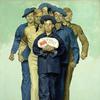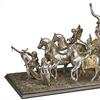Featured 19th Century Painter: FREDERICK MULHAUPT (AMERICAN 1871 - 1938)
- July 22, 2020 11:04
Frederick Mulhaupt was born in Rock Port, Missouri and spent his early years in Kiowa, Kansas. From an inauspicious beginning as a newspaper reporter in Dodge City, Kansas, Malhaupt took the first step that would ultimately lead him to become the “Dean of the Cape Ann School” in Massachusetts. He initially enrolled at the Kansas City School of Design, followed by a move to Chicago, Illinois, circa 1890, where he studied at the Art Institute of Chicago. While there, he became a founding member of the Palette and Chisel Club in 1895 and taught figure painting from 1902 to 1904. He then moved to New York City where he roomed at the Salmagundi Club. Mulhaupt furthered his art training by studies in Paris, France, where he was exposed to the work of the Impressionists, a still thriving art style. While in Europe, Mulhaupt visited the fishing village of St. Ives in Cornwall, England where he painted the fishermen hauling in their catch. After some years in Europe, he returned to New York City and to the Salmagundi Club, but only during winter. In 1907 he had begun spending summers in Gloucester, Massachusetts, finally moving there permanently in 1922. Once he discovered the picturesque Cape Ann and his own perfect spot on Rocky Neck, Malhaupt never desired to paint elsewhere. He captured Cape Ann's docks, wharfs, boats, and workmen in his own Impressionist style derived from his time in France. Perhaps sparked by his time at St. Ives, he became known for his landscape and seascapes of the Cape Ann area, so skillful in fact that it prompted artist and friend Emile Gruppé to state that Mulhaupt “got the smell of Gloucester on canvas. He captured the mood of the place – and that’s worth all the good drawings of a hundred lesser painters.” Like another American plein air painter, William Preston Phelps (1848–1917), Mulhaupt, favored winter landscapes. During the Depression of the 1930’s, U.S. President Franklin Delano Roosevelt established the Works Progress Administration (WPA), under which a subdivision, the Federal Art Project (FAP), was established to provide economic relief to artists. A number of well-known artists, including Mulhaupt, participated as a WPA artist. His WPA-era murals are displayed in Gloucester City Hall and the former Maplewood School on Dale Avenue. Mulhaupt was a member of Palette and Chisel Club (founder), Chicago; North Shore Arts Association (founder).; National Academy of Design; National Arts Club; Salmagundi Club; Allied Artists of America; Boston Arts Club; Rockport Art Association; North Shore Art Association, Gloucester. He exhibited at the Allied Artists of America (prizes 1925, 1930); National Academy of Design (prize, 1925); National Arts Club (honorable mention, 1929); North Shore Art Association, Gloucester; Palette & Chisel Club; Salmagundi Club (Evans Prize, 1907 and Porter Prize, 1921); Art Institute of Chicago; Corcoran Gallery and/or Art School, Washington DC; The Pennsylvania Academy of the Fine Arts; and the Sesqui-Centennial International Exhibition (Philadelphia, 1926, medal); Connecticut Academy of Fine Arts (Gedney Bunce Prize, 927); and the Ogunquit Art Association (prizes, 931, 1932).





















